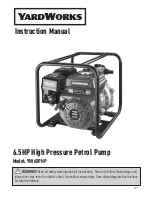
Instruction Handbook PFP-23hpVGD-2D
- 14 -
C.E.T. Fire Pumps Mfg. This handbook is subject to change without notice,
Contact your local C.E.T. dealer or C.E.T. direct to ensure you have the latest version.
7.4.
Connect the suction hose and the discharge hose. Make sure that
there is a rubber seal on the adapter and screw it tight. Verify the water
source to be used is clear of sand and/or small rocks, if you have any doubt
about your water source, we recommend you use a floating strainer. If
sand enters your pump it would damage the seal and wear rings, reducing
useful life. The water source should be at least 12” deep.
WARNING: The discharge hose will tend to straighten up when filled with
water. Make sure it won’t compromise the safety of your installation. Warn
the surrounding people before you start the pump. It is important that you
evaluate the trajectory of the hose to prevent incidents.
NOTE: If you are pumping from a hydrant, replace step 7.7 by: “open the valve or
any other control mechanism of the hydrant to fill your pump”. Follow the rest of
the procedure but skipping section 7.9 to 7.13. We recommend you avoid having
an inlet pressure over 75 PSI, it will accelerate wear of the mechanical seal.
7.5.
Put the control throttle in starting position.
7.6.
Close the drain valve and the discharge valves, make sure the pump
is sealed from any air leakage.
7.7.
Open the priming valve.
WARNING: Always make sure a trained person firmly holds the extremity of
the discharge hose before starting the engine. The hydraulic power of the
pump could cause the hose and nozzle to move violently and cause material
damage, severe injuries or even death.









































